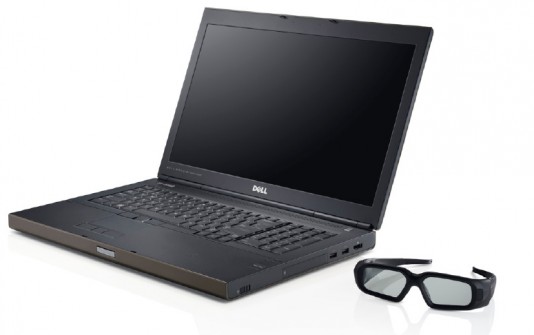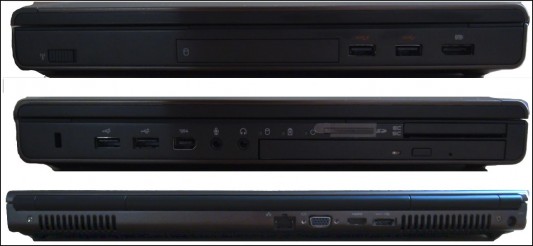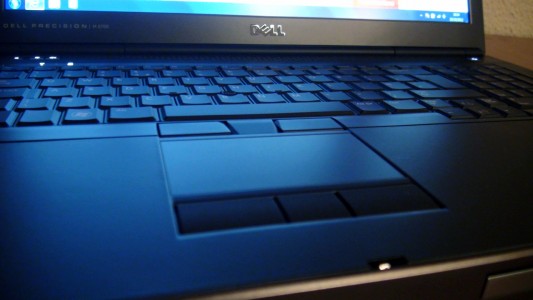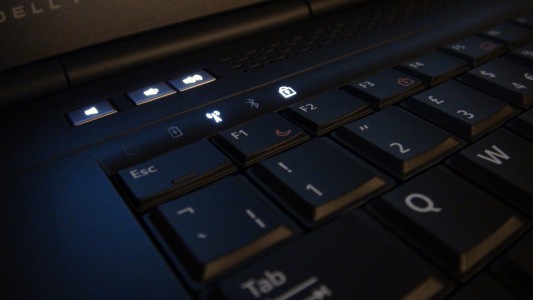The combination of an Intel Core i7 hyperthreading processor, an AMD FirePro 6000M, and stylish, thoughtful design makes the M6700 a winner.
By Tom Lansford
The new 17-inch Dell M6700 mobile workstation brings together third-generation Intel Core i7 computing power with an AMD FirePro professional graphics GPU, a classy and rugged design, along with expandability and capacity that feels like a desktop ready to hit the road.

The first impression? This is a nice 17-inch professional workstation. The aluminum and magnesium alloy chassis has a simple, stylist look and a solid feel; the perfect combination for professionals. The style is clean and understated. Everything feels solid and firm. No flexing, no weak spots, but not overly imposing or, at a hair over 7.7 pounds (3.5 kg), overly heavy either.
The review unit came equipped with an Intel Core i7-3920XM Processor Extreme Edition running at 2.9 GHz with a maximum Turbo Boost 2.0 clock speed of 3.8 GHz. The M6700 can be equipped with either an AMD or NVIDIA GPU; our unit came with the AMD FirePro 6000M. Not only are professional GPUs tested and certified for professional applications—be it Catia, Revit, Creo, SolidWorks or others—the GPU will also be optimized for the best performance on those applications. AMD has worked with software vendors to optimize the performance of the FirePro on CAD and design software. Finally, storage capacity and memory are not going to be an issue for most customers. The M6700 supports up to 32GB of memory, and up to 4 storage devices including hard drives and SSD drives.
The workstation is quiet; I love it. The system is next to me now running the Viewperf benchmark and I can hardly hear it. Last year I had a mobile workstation from a different vendor which made more noise while idling.
Well connected
The machine can be configured with 32 bit and 64 bit versions of Windows and Linux Red Hat operating systems. If you use 32GB of RAM, then you can use the 1600 MHz memory. Optionally, the system can use up to 16GB of RAM clocked at 1866 MHz. The display’s maximum resolution is 1920 x 1080. Several versions of the Dell Ultra Sharp display are available as options. The optical drive can write Blue-ray discs, and the optical drive can be replaced with an additional hard drive.
The unit has a large number of connections (listed at the end of the article). A thoughtful move by Dell was to place the two USB 3.0 connections on the right side of the mobile workstation and the two USB 2.0 connections of the left side of the unit. There is also a 10-in-1 media card reader and a smart card reader. It is possible to connect a display to any one of three connectors, VGA, HDMI, and DisplayPort. The FirePro 6000M also supports AMD’s Eyefinity multiple display management feature.

The weight makes it heavier than a 17-inch MacBook Pro, but it is significantly less than the hefty Celsius H920 I reviewed recently. The 240W power adapter is going to weigh down your computer bag in addition to that, but for a professional, certified 17-inch workstation, this is a pretty reasonable trade-off in performance, capacity, and mobility.
The keyboard offers a separate number pad which is common on this class of mobile workstation and convenient for data entry while working with design and CAD software. The keyboard has a nice solid feel, with the keys being quite tactile. After a day or two for your fingers to adapt to this keyboard, it should feel quite comfortable—especially with the large wrist-pad area in front of the keyboard. The touchpad has two sets of buttons on it and the keyboard is home to a track-stick. If you use the track-stick, then you will appreciate the extra buttons at the top of the touch pad which can be used easily with the track-stick.

For professional graphics, the Precision M6700 offers options for the AMD FirePro 6000M (my test unit), the NVIDIA Quadro K3000, NVIDIA Quadro K4000, & NVIDIA Quadro K5000. The specification for the AMD FirePro 6000M shows the GPU characteristics and it supports multiple displays.
A professional GPU is critical for the graphics performance in professional applications. The FirePro is tested on, optimized for, and certified with professional software. While several important software vendors (ISVs) perform workstation-level certifications, the majority certify specifically the GPU.
Of course the Intel Core i7 CPU is critical to system performance. The third-generation Core architecture on the M6700 has a four-core, hyperthreading CPU with Turbo Boost Technology 2.0, and PCI Express Gen 3 support. Like the other systems CADplace has reviewed, the multi-core, multi-threaded CPU gives the system maximum performance for calculations typical in engineering simulations and high-quality rendering. Turbo Boost Technology 2.0 squeezes the most from the CPU when the application is not loading all the CPU cores with tasks by increasing the clock speeds of the active core(s) dynamically. And PCI Express Generation 3 doubles the speed of data transfers within the workstation architecture, namely between the main sub-systems of CPU, memory, and GPU.

For workstation performance, I ran the Viewperf benchmark on the M6700. Focusing on graphics performance, this benchmark utilizes test data which is representative of professional graphics applications. The Viewperf benchmark is created and managed by specbench.org and is designed to provide performance-comparison data for graphics workstations. The datasets are designed on industry applications for engineering, architecture, and visualization including Catia, SolidWorks, Allplan, Lightwave, Siemens NX, and Creo. In addition to using representative datasets, the benchmarks are the results of collaboration and peer-review within the industry. Therefore, comparative testing with Viewperf will provide good information on relative graphics performance for professional usage.
For application specific evaluation, the SPECbench organization also has application-level benchmarks for several leading applications in different professional domains. These are called the SPECapc benchmarks – there is more information at http://www.spec.org/benchmarks.html
The CADplace/GraphicSpeak results for Viewperf on this Dell Precision M6700 are:
Contributing Writer Tom Lansford is Editor of CADplace.uk and CADplace.fr, where a longer version of this review originally appeared. GraphicSpeak and CADplace occasionally share articles.
Related
Review: Lenovo Thinkpad W530 makes “mobile workstation” so not an oxymoron






